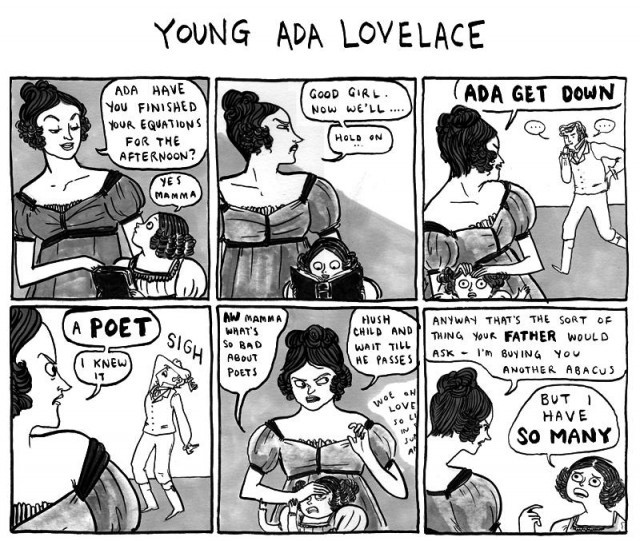Happy Ada Lovelace / Women in Tech Day! Let’s Learn History
Happy Ada Lovelace Day!

We are all about #STEM in these parts, and Women in #STEM, and Women in General, and Everyone Living their Best Lives, which of course includes knowing History and … wait, where are you going? Stay with me, this will be great. Lady Ada Lovelace was a nearly Lisbeth Salander-level badass:
She was arguably the first computer programmer, in 1834, and the only legitimate daughter of Lord Byron. Though she didn’t know Byron well, her famous father cast a shadow over her life and inspired her creativity. When Ada was twelve, she was obsessed with bird flight. She sketched design after design for a “steam-driven, mechanical flying horse.” Her mother set up a strict tutoring schedule, with an emphasis on mathematics and music, which later fueled her intellectual work. … In October 1842, Luigi Federico Menabrea published an article about Babbage’s Analytical Engine in Bibliotheque Universelle de Geneve. Lovelace translated it and added her own notes, about 20,000 words, to the 8,000 word piece. Published in 1843, her notes include a much deeper understanding of the potential for Babbage’s machine, including the suggestion that it was “capable of executing not merely arithmetical calculations, but even all those of analysis.” … In 1941, Alan Turing gave Lovelace credit for some of her remarkable ideas. In Lady Lovelace’s Objection, he expanded upon a line from her memoir, that machines cannot originate ideas; in her words, the Analytical Engine can only do what we ask it to perform.
Babbage, you may remember, was the mathematician forefather of the computer; Turing helped the Allies win WWII; and Byron was a terminally Romantic pansexual poet whose talent was exceeded only by his libido and his ability to make terrible life choices. As we know, though, our society is not encouraging the Ada Lovelaces of today. In fact, as Ann Friedman points out in Medium, tech remains about as sexist as a pirate ship:
Only 25 percent of tech workers are women, compared with 57 percent of the overall workforce. And just look at who’s holding the purse strings: Only 4 percent of senior venture capitalists are women, and 19 percent of U.S. angel investors are women. Is it any wonder that men are 40 percent more likely to be funded by venture capitalists, and only 4 to 7 percent of startup founders are women? (Well, that number is disputed, but almost everyone agrees it’s single-digit.) Software developers, the darlings of the tech gold rush, are only 20 percent women. A third of female tech entrepreneurs reported facing “dismissive attitudes” from their co-workers. And the future doesn’t look very bright. Only 18 percent of computer-science college graduates were women in 2012, down from 37 percent in 1985. This year, only 15 percent of freshman women at American colleges plan to declare a STEM major, compared with 29 percent of men. Even when women break into tech, they don’t stay. More than half — 56 percent — end up leaving the industry.
A little depressing, sure. But we have GoldieBlox, and a whole host of women who have succeeded before now against the odds (including Hedy Lamarr), and a camp whose purpose is to get girls to Be Like Ada, and a man in charge of Microsoft whose consciousness has been rather forcefully raised. Maybe there is some cause for optimism yet. Comic via Kate Beaton, of course. And thanks Kirsten!
Support The Billfold
The Billfold continues to exist thanks to support from our readers. Help us continue to do our work by making a monthly pledge on Patreon or a one-time-only contribution through PayPal.
Comments